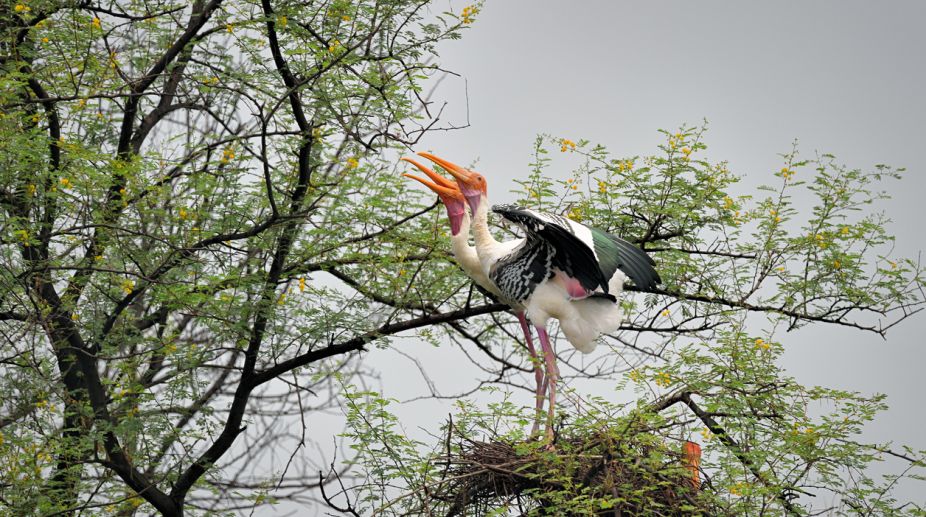Though the visit was not according to exact seasonal timings, the habitats of the Keoladeo Ghana National Park (formerly the Bharatpur Bird Sanctuary) in Rajasthan put forth a bountiful welcome. One’s joy knew no bounds after finding a Crested Serpent Eagle after a brisk walk! The long metalled road constructed to the very depths of the sanctuary allows only eco-friendly human pedalled trishaws. From the entrance gate, both sides of the road are hemmed in by bushes and shrubs, big trees, swamps and wetlands.
An Egret perched on a kadam tree gave me a stern look as I passed too close! It was 2 pm but the scorching heat could not dampen my spirits. The trishaw puller acted as the guide and narrated what sorts of birds were occasional visitors in winter — Siberian Crane (critically endangered), Common Crane, Demomoiselle, Spoonbill, Pelicans and Flamingos among others. A brief look at the history of the park is much warranted.
Jath Sardar Surajmal founded Bharatpur town at the confluence of Ruparel and Bunganga rivers in 1730. In 1825, the British conquered the state although it maintained a friendship treaty. Within this kingdom an arid area measuring 28.73 sq km often remained inundated throughout the rainy season and became a duck shooting ground for Maharajas.
Actually the sanctuary came into being with the effort of Maharaja Brajendra Singh though hunting went on full swing. In 1964, it was Dr Salim Ali, the birdman of India, who raised his voice first against such wanton killings. In 1972, the menace was stopped by applying the Wild Life Protection Act. Crowned with the status of a National Park in 1982, the sanctuary was recognised as World Heritage Site by Unesco in 1985. Further it was also declared a Ramsar Site under Ramsar Convention in 1982.But why the name, Keoladeo Ghana National Park? The manager of the hotel clarified the myth. Deep inside the forest a temple of Lord Shiva (locally known as “Keoladeo Baba”) exists, so it is in his name.
Profusely perspiring, I entered the Salim Ali Visitor Interpretation Centre located within the park. Description and photographs of birds are so neatly presented that a patient reading will definitely enrich one’s knowledge. The centre is well maintained.
The sanctuary records the visit of migratory birds from Siberia, Tibet, China, Afghanistan because it is positioned on the Central Asian Flyway. It acts as a shelter for about 366 bird species, 379 floral species, 50 species of fishes, 13 species of snakes and some other invertebrates. The centre pays a true homage to India’s most revered ornithologist.
The rainfall this year was highest in the last forty years and so large bushes were in abundant growth. Continuously chirping jungle babblers were too busy to acknowledge the presence of humans. I saw two large parakeets preparing their nest on a solar panel! Suddenly, the guide pointed to a bush. A hissing sound forced me to look at a viper with a wide open jaw confronting a large frog. A little onward, Sambars were chewing creepers and leaves in the dense bushes submerged in water.
Dusk covers the area within an hour and one was advised to make it quick. The wetlands were wider and numerous Painted Storks on top of large acacia trees came into view. Some were busy in arranging their nests and some in feeding their chicks. These storks prefer shallow sweet water wetlands and small fishes.
The nests are so well-knitted that they accommodate these heavy birds. Cormorants, in the fading sunlight, were cleaning their wings after a day-long hunt for food. It was time to go back but a Night Heron just woke up. This species of heron rests in the day and hunts at dark. A group of bird watchers from the Forest Research Institute, Dehradun pointed out a group of Pelicans flying in a v-shape.
We counted 18 of them and they were in search of a suitable location for their nest. Their presence is a signal for the arrival of migratory birds. Sir Peter Scott, founder of the World Wildlife Fund, adjudged the park as the world’s best bird sanctuary. One must also mention the Rajasthan Forest Department that manages the park. Their efforts in helping maintain the unique ecosystem has truly created an ideal home for the birds and other wildlife.











